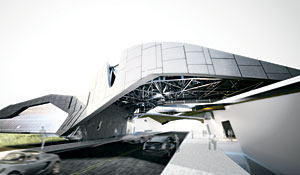Colliding tectonic plates, deep canyons, craggy overhangs, and other heroic topographic features are often evoked in the architecture of Morphosis, the Los Angeles-based firm. But the architects’ first project in China, Giant Group Pharmaceutical Campus, has allowed them to push that exploration even further, says Morphosis principal Thom Mayne. “In China, you can do things formally you just can’t do in the U.S.—aggressive, uncompromised, out-there ideas.”

Sited on 3.2 hectares in Shanghai’s western outskirts, Giant’s new corporate headquarters, slated for completion in April 2009, is a single-structure “campus”—a sinuous 24,000-square-meter building with myriad and, in some cases, separately articulated components. Most prominently, a long, curving office element, spanning a four-lane highway, bridges the so-called East and West Campuses, culminating in dynamic cantilevered ends, 33 and 38 meters long. To either side of the road, this complex building undulates in and out of a highly sculpted landscape, amid existing canals and a new manmade lake.
Striving for a seamless continuum between architecture and site, Morphosis radically reinvented the topography, introducing what the architects call an “augmented ground plane” or “lifted landscape.” Beneath it, they embedded programmatic elements: a library, auditorium, exhibition space, and cafeteria on the East Campus; and employee athletic facilities, including a swimming pool, on the West Campus, where the ground plane doubles as an undulating planted roof. Projecting over the lake, the complex’s west end also offers hotel facilities: a bar, restaurant, and 17 glass-floored guest rooms for visiting business associates. Plazas, paths, and decks, with water access, interlace indoors and out.
Geometrically idiosyncratic, the building combines braced steel moment frames, for the cantilevers, with concrete-and-steel structure, for low-lying elements. As a hybrid—not just structurally, but also formally and programmatically—the scheme successfully “adapted to dynamic change” during the design process, when, says project manager Tim Christ, the client decided to emphasize its computer-games subsidiary, rather than its pharmaceutical division, as originally planned.
With equal flexibility, the design enhances the workplace environment and energy efficiency. A grand stairway—a communal zone leading to the main circulation spine, on the second level—encourages employees to walk, rather than ride elevators. Abundant daylight, entering through skylights and across narrow floor plates, reduces the need for electric illumination. Limiting solar heat gain and cooling costs, the green roof provides thermal mass, while the facade’s cement-fiberboard paneling and double-layer, fritted-glass curtain wall boost insulation and shading.
With its great cantilevered snout and cement-fiberboard scales, Giant Group’s new building has already earned a fortuitous nickname: not “The Tectonic Plate,” but “The Dragon.”




Post a comment to this article
Report Abusive Comment